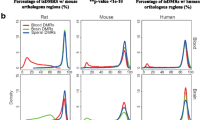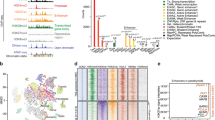Abstract
Much of the DNA in genomes is organized within gene families and hierarchies of gene superfamilies. DNA methylation is the main epigenetic event involved in gene silencing and genome stability. In the present study, we analyzed the DNA methylation status of the prolactin (PRL) superfamily to obtain insight into its tissue-specific expression and the evolution of its sequence diversity. The PRL superfamily in mice consists of two dozen members, which are expressed in a tissue-specific manner. The genes in this family have CpG-less sequences, and they are located within a 1-Mb region as a gene cluster on chromosome 13. We tentatively grouped the family into several gene clusters, depending on location and gene orientation. We found that all the members had tissue-dependent differentially methylated regions (T-DMRs) around the transcription start site. The T-DMRs are hypermethylated in nonexpressing tissues and hypomethylated in expressing cells, supporting the idea that the expression of the PRL superfamily genes is subject to epigenetic regulation. Interestingly, the DNA methylation patterns of T-DMRs are shared within a cluster, while the patterns are different among the clusters. Finally, we reconstituted the nucleotide sequences of T-DMRs by converting TpG to CpG based on the consideration of a possible conversion of 5-methylcytosine to thymine by spontaneous deamination during the evolutionary process. On the phylogenic tree, the reconstituted sequences were well matched with the DNA methylation pattern of T-DMR and orientation. Our study suggests that DNA methylation is involved in tissue-specific expression and sequence diversity during evolution.




Similar content being viewed by others
References
Bhattacharyya S, Lin J, Linzer D (2002) Reactivation of a hematopoietic endocrine program of pregnancy contributes to recovery from thrombocytopenia. Mol Endocrinol 16:1386–1393
Carbone L, Harris RA, Vessere GM, Mootnick AR, Humphray S, Rogers J, Kim SK, Wall JD, Martin D, Jurka J, Milosavljevic A, de Jong PJ (2009) Evolutionary breakpoints in the gibbon suggest association between cytosine methylation and karyotype evolution. PLoS Genet 5:e1000538
Cho J, Kimura H, Minami T, Ohgane J, Hattori N, Tanaka S, Shiota K (2001) DNA methylation regulates placental lactogen I gene expression. Endocrinology 142:3389–3396
Choong ML, Tan AC, Luo B, Lodish HF (2003) A novel role for proliferin-2 in the ex vivo expansion of hematopoietic stem cells. FEBS Lett 550:155–162
Coulondre C, Miller JH, Farabaugh PJ, Gilbert W (1978) Molecular basis of base substitution hotspots in Escherichia coli. Nature 274:775–780
Dai G, Wang D, Liu B, Kasik JW, Müller H, White RA, Hummel GS, Soares MJ (2000) Three novel paralogs of the rodent prolactin gene family. J Endocrinol 166:63–75
Fassett J, Nilsen-Hamilton M (2001) Mrp3, a mitogen-regulated protein/proliferin gene expressed in wound healing and in hair follicles. Endocrinology 142:2129–2137
Hattori N, Nishino K, Ko Y, Ohgane J, Tanaka S, Shiota K (2004) Epigenetic control of mouse Oct-4 gene expression in embryonic stem cells and trophoblast stem cells. J Biol Chem 279:17063–17069
Hiraoka Y, Ogawa M, Sakai Y, Takeuchi Y, Komatsu N, Shiozawa M, Tanabe K, Aiso S (1999) PLP-I: a novel prolactin-like gene in rodents. Biochim Biophys Acta 1447:291–297
Ho Y, Liebhaber SA, Cooke NE (2004) Activation of the human GH gene cluster: roles for targeted chromatin modification. Trends Endocrinol Metab 15:40–45
Ho-Chen J, Bustamante J, Soares M (2007) Prolactin-like protein-f subfamily of placental hormones/cytokines: responsiveness to maternal hypoxia. Endocrinology 148:559–565
Imamura T, Ohgane J, Ito S, Ogawa T, Hattori N, Tanaka S, Shiota K (2001) CpG island of rat sphingosine kinase-1 gene: tissue-dependent DNA methylation status and multiple alternative first exons. Genomics 76:117–125
Janion C (1982) Influence of methionine on the mutation frequency in Salmonella typhimurium. Mutat Res 94:331–338
Khulan B, Thompson RF, Ye K, Fazzari MJ, Suzuki M, Stasiek E, Figueroa ME, Glass JL, Chen Q, Montagna C, Hatchwell E, Selzer RR, Richmond TA, Green RD, Melnick A, Greally JM (2006) Comparative isoschizomer profiling of cytosine methylation: the HELP assay. Genome Res 16:1046–1055
Kimura F, Takakura K, Takebayashi K, Ishikawa H, Kasahara K, Goto S, Noda Y (2001) Messenger ribonucleic acid for the mouse decidual prolactin is present and induced during in vitro decidualization of endometrial stromal cells. Gynecol Endocrinol 15:426–432
Kimura AP, Sizova D, Handwerger S, Cooke NE, Liebhaber SA (2007) Epigenetic activation of the human growth hormone gene cluster during placental cytotrophoblast differentiation. Mol Cell Biol 27:6555–6568
Li E (2002) Chromatin modification and epigenetic reprogramming in mammalian development. Nat Rev Genet 3:662–673
Lin J, Poole J, Linzer DI (1997) Three new members of the mouse prolactin/growth hormone family are homologous to proteins expressed in the rat. Endocrinology 138:5541–5549
Linzer DI, Nathans D (1984) Nucleotide sequence of a growth-related mRNA encoding a member of the prolactin-growth hormone family. Proc Natl Acad Sci USA 81:4255–4259
Long M (2001) Evolution of novel genes. Curr Opin Genet Dev 11:673–680
Louis E (2007) Evolutionary genetics: making the most of redundancy. Nature 449:673–674
Mallon AM, Wilming L, Weekes J, Gilbert JG, Ashurst J, Peyrefitte S, Matthews L, Cadman M, McKeone R, Sellick CA, Arkell R, Botcherby MR, Strivens MA, Campbell RD, Gregory S, Denny P, Hancock JM, Rogers J, Brown SD (2004) Organization and evolution of a gene-rich region of the mouse genome: a 12.7-Mb region deleted in the Del(13)Svea36H mouse. Genome Res 14:1888–1901
Müller H, Ishimura R, Orwig KE, Liu B, Soares MJ (1998) Homologues for prolactin-like proteins A and B are present in the mouse. Biol Reprod 58:45–51
Muramoto H, Yagi S, Hirabayashi K, Sato S, Ohgane J, Tanaka S, Shiota K (2010) Enrichment of short interspersed transposable elements to embryonic stem cell-specific hypomethylated gene regions. Genes Cells 15:855–865
Nishino K, Hattori N, Tanaka S, Shiota K (2004) DNA methylation-mediated control of Sry gene expression in mouse gonadal development. J Biol Chem 279:22306–22313
Orwig KE, Ishimura R, Müller H, Liu B, Soares MJ (1997) Identification and characterization of a mouse homolog for decidual/trophoblast prolactin-related protein. Endocrinology 138:5511–5517
Rakyan V, Down T, Thorne N, Flicek P, Kulesha E, Gräf S, Tomazou E, Bäckdahl L, Johnson N, Herberth M, Howe K, Jackson D, Miretti M, Fiegler H, Marioni J, Birney E, Hubbard T, Carter N, Tavaré S, Beck S (2008) An integrated resource for genome-wide identification and analysis of human tissue-specific differentially methylated regions (tDMRs). Genome Res 18:1518–1529
Russell GJ, Walker PM, Elton RA, Subak-Sharpe JH (1976) Doublet frequency analysis of fractionated vertebrate nuclear DNA. J Mol Biol 108:1–23
Sato S, Yagi S, Arai Y, Hirabayashi K, Hattori N, Iwatani M, Okita K, Ohgane J, Tanaka S, Wakayama T, Yamanaka S, Shiota K (2010) Genome-wide DNA methylation profile of tissue-dependent and differentially methylated regions (T-DMRs) residing in mouse pluripotent stem cells. Genes Cells 15:607–618
Saxonov S, Berg P, Brutlag DL (2006) A genome-wide analysis of CpG dinucleotides in the human genome distinguishes two distinct classes of promoters. Proc Natl Acad Sci USA 103:1412–1417
Shiota K (2004) DNA methylation profiles of CpG islands for cellular differentiation and development in mammals. Cytogenet Genome Res 105:325–334
Shiota K, Kogo Y, Ohgane J, Imamura T, Urano A, Nishino K, Tanaka S, Hattori N (2002) Epigenetic marks by DNA methylation specific to stem, germ and somatic cells in mice. Genes Cells 7:961–969
Simmons D, Rawn S, Davies A, Hughes M, Cross J (2008) Spatial and temporal expression of the 23 murine prolactin/placental lactogen-related genes is not associated with their position in the locus. BMC Genomics 9:352
Soares M (2004) The prolactin and growth hormone families: pregnancy-specific hormones/cytokines at the maternal-fetal interface. Reprod Biol Endocrinol 2:51
Soares M, Alam S, Duckworth M, Horseman N, Konno T, Linzer D, Maltais L, Nilsen-Hamilton M, Shiota K, Smith J, Wallis M (2007a) A standardized nomenclature for the mouse and rat prolactin superfamilies. Mamm Genome 18:154–156
Soares MJ, Konno T, Alam SM (2007b) The prolactin family: effectors of pregnancy-dependent adaptations. Trends Endocrinol Metab 18:114–121
Suzuki M, Sato S, Arai Y, Shinohara T, Tanaka S, Greally JM, Hattori N, Shiota K (2007) A new class of tissue-specifically methylated regions involving entire CpG islands in the mouse. Genes Cells 12:1305–1314
Thompson J, Higgins D, Gibson T (1994) CLUSTAL W: improving the sensitivity of progressive multiple sequence alignment through sequence weighting, position-specific gap penalties and weight matrix choice. Nucleic Acids Res 22:4673–4680
Toft DJ, Linzer DI (1999) Prolactin (PRL)-like protein J, a novel member of the PRL/growth hormone family, is exclusively expressed in maternal decidua. Endocrinology 140:5095–5101
Toft DJ, Rosenberg SB, Bergers G, Volpert O, Linzer DI (2001) Reactivation of proliferin gene expression is associated with increased angiogenesis in a cell culture model of fibrosarcoma tumor progression. Proc Natl Acad Sci USA 98:13055–13059
Tomikawa J, Fukatsu K, Tanaka S, Shiota K (2006) DNA methylation-dependent epigenetic regulation of dimethylarginine dimethylaminohydrolase 2 gene in trophoblast cell lineage. J Biol Chem 281:12163–12169
Wiemers D, Shao L, Ain R, Dai G, Soares M (2003) The mouse prolactin gene family locus. Endocrinology 144:313–325
Wolfe KH, Sharp PM, Li WH (1989) Mutation rates differ among regions of the mammalian genome. Nature 337:283–285
Yagi S, Hirabayashi K, Sato S, Li W, Takahashi Y, Hirakawa T, Wu G, Hattori N, Ohgane J, Tanaka S, Liu XS, Shiota K (2008) DNA methylation profile of tissue-dependent and differentially methylated regions (T-DMRs) in mouse promoter regions demonstrating tissue-specific gene expression. Genome Res 18:1969–1978
Acknowledgments
This research was funded by grants from Grant-in-Aid for Scientific Research from the Ministry of Education, Culture, Sports, Science, and Technology (MEXT), Japan (21221008 to Kunio Shiota), and the National Institute of Biomedical Innovation (NIBIO), Japan. We thank Dr. Naoko Hattori and Dr. Shinya Sato for their helpful suggestions regarding analysis.
Conflicts of interest
The authors have no conflicts of interest to declare.
Author information
Authors and Affiliations
Corresponding author
Electronic supplementary material
Below is the link to the electronic supplementary material.
335_2011_9383_MOESM3_ESM.tif
Supplementary material 3: Supplementary Fig. 1: LINE-rich/SINE-poor proportions in mouse PRL superfamily gene cluster. Repeat markers were visualized by USCS genome browser (mm8) (TIFF 2322 kb)
Rights and permissions
About this article
Cite this article
Hayakawa, K., Nakanishi, M.O., Ohgane, J. et al. Bridging sequence diversity and tissue-specific expression by DNA methylation in genes of the mouse prolactin superfamily. Mamm Genome 23, 336–345 (2012). https://doi.org/10.1007/s00335-011-9383-x
Received:
Accepted:
Published:
Issue Date:
DOI: https://doi.org/10.1007/s00335-011-9383-x




